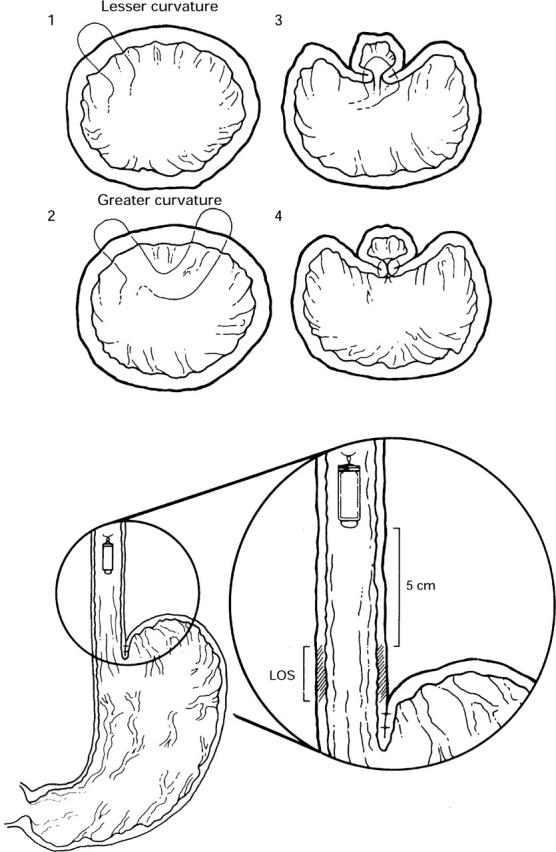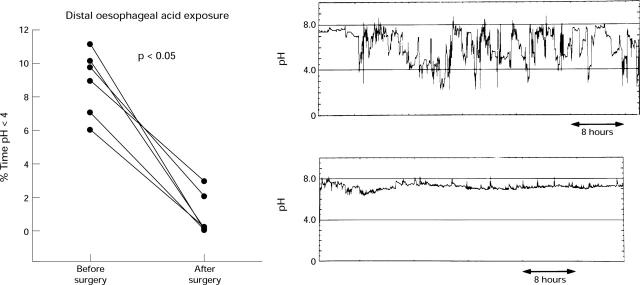Abstract
BACKGROUND—There is a lack of suitable models for testing of therapeutic procedures for gastro-oesophageal reflux disease. Endoscopic sewing methods might allow the development of a new less invasive surgical approach to treatment of gastrointestinal disorders. AIMS—To develop an animal model of gastro-oesophageal reflux for testing the efficacy of a new antireflux procedure, endoscopic gastroplasty, performed at flexible endoscopy without laparotomy or laparoscopy. METHODS—At endoscopy a pH sensitive radiotelemetry capsule was sewn to the oesophageal wall, 5 cm above the lower oesophageal sphincter, in six large white pigs. Ambulant pH recordings (48-96 hours; total 447 hours) were obtained. The median distal oesophageal pH was 6.8 (range 6.4-7.3); pH was less than 4 for 9.3% of the time. After one week, endoscopic gastroplasty was performed by placing sutures below the gastro-oesophageal junction, forming a neo-oesophagus of 1-2 cm in length. Postoperative manometry and pH recordings (24-96 hours; total 344 hours) were carried out. RESULTS—Following gastroplasty, the median sphincter pressure increased significantly from 3 to 6 mm Hg and in length from 3 to 3.75 cm. The median time pH was less than 4 decreased significantly from 9.3% to 0.2%. CONCLUSIONS—These are the first long term measurements of oesophageal pH in ambulant pigs. The finding of spontaneous reflux suggested a model for studying treatments of reflux. Endoscopic gastroplasty increased sphincter pressure and length and decreased acid reflux. Keywords: gastro-oesophageal reflux; endoscopic gastroplasty; manometry
Full Text
The Full Text of this article is available as a PDF (144.0 KB).
Figure 1 .

Endoscopic gastroplasty. Diagram indicates transverse and longitudinal section through the oesophagus and stomach to indicate the placement of stitches and site of implantation of radiotelemetry capsule. Two stitches are placed immediately below the cardio-oesophageal junction; the tissue is pulled together and tied with four half hitches. A separate pair of stitches is placed 1 cm below the first. There are several possible mechanisms by which endoscopic gastroplasty might improve reflux: it creates a neo-oesophagus out of gastric tissue, thus increasing the exposure of the lower oesophageal sphincter (LOS) to positive intra-abdominal pressure; it may increase lower oesophageal sphincter pressure by placing a tuck in the muscle layer at the lower end of the sphincter; it may make the angle of this more acute; by decreasing the potential for relaxation of the gastric sling fibres distension induced lower oesophageal sphincter relaxation may be reduced.
Figure 2 .
Preoperative and postoperative distal oesophageal acid exposure. Endoscopic gastroplasty significantly decreased acid reflux (p<0.05). The top trace shows preoperative 48 hour pH profile and the bottom trace shows postoperative 48 hour pH profile of the distal oesophagus.
Selected References
These references are in PubMed. This may not be the complete list of references from this article.
- Arndorfer R. C., Stef J. J., Dodds W. J., Linehan J. H., Hogan W. J. Improved infusion system for intraluminal esophageal manometry. Gastroenterology. 1977 Jul;73(1):23–27. [PubMed] [Google Scholar]
- BRAASCH J. W., ELLIS F. H., Jr The gastroesophageal sphincter mechanism: an experimental study. Surgery. 1956 Jun;39(6):901–905. [PubMed] [Google Scholar]
- Baue A. E., Hoffer R. E. The effects of experimental hiatal hernia and histamine stimulation on the intrinsic esophageal sphincter. Surg Gynecol Obstet. 1967 Oct;125(4):791–799. [PubMed] [Google Scholar]
- Beauchamp G., Devito M., Bourgie J., Lamoureux C. Modèles expérimentaux de reflux gastro-oesophagien. Union Med Can. 1986 Jun;115(6):387–392. [PubMed] [Google Scholar]
- Bremner C. G., Lynch V. P., Ellis F. H., Jr Barrett's esophagus: congenital or acquired? An experimental study of esophageal mucosal regeneration in the dog. Surgery. 1970 Jul;68(1):209–216. [PubMed] [Google Scholar]
- Cohen D. J., Benjamin S. B., Graeber G. M., Castell D. O., Patrick D. H., Cordova C., Dachman A., Friedman A. Evaluation of the Angelchik antireflux prosthesis using a model for esophageal reflux in rhesus monkeys. Ann Thorac Surg. 1986 Feb;41(2):135–142. doi: 10.1016/s0003-4975(10)62653-7. [DOI] [PubMed] [Google Scholar]
- Donahue P. E., Carvalho P. J., Davis P. E., Shen Y. J., Miidla I., Bombeck C. T., Nyhus L. M. Endoscopic sclerosis of the gastric cardia for prevention of experimental gastroesophageal reflux. Gastrointest Endosc. 1990 May-Jun;36(3):253–256. doi: 10.1016/s0016-5107(90)71017-6. [DOI] [PubMed] [Google Scholar]
- Eastwood G. L., Castell D. O., Higgs R. H. Experimental esophagitis in cats impairs lower esophageal sphincter pressure. Gastroenterology. 1975 Jul;69(1):146–153. [PubMed] [Google Scholar]
- Gillen P., Keeling P., Byrne P. J., West A. B., Hennessy T. P. Experimental columnar metaplasia in the canine oesophagus. Br J Surg. 1988 Feb;75(2):113–115. doi: 10.1002/bjs.1800750208. [DOI] [PubMed] [Google Scholar]
- Gillison E. W., De Castro V. A., Nyhus L. M., Kusakari K., Bombeck C. T. The significance of bile in reflux esophagitis. Surg Gynecol Obstet. 1972 Mar;134(3):419–424. [PubMed] [Google Scholar]
- Heij H. A., Seldenrijk C. A., Vos A. Anterior gastropexy prevents gastrostomy-induced gastroesophageal reflux: an experimental study in piglets. J Pediatr Surg. 1991 May;26(5):557–559. doi: 10.1016/0022-3468(91)90706-y. [DOI] [PubMed] [Google Scholar]
- Henderson R. D., Mugashe F. L., Jeejeebhoy K. N., Szczpanski M. M., Cullen J., Marryatt G., Boszko A. Synergism of acid and bile salts in the production of experimental esophagitis. Can J Surg. 1973 Jan;16(1):12–17. [PubMed] [Google Scholar]
- Hill L. D. Intraoperative measurement of lower esophageal spincter pressure. J Thorac Cardiovasc Surg. 1978 Mar;75(3):378–382. [PubMed] [Google Scholar]
- Jamieson G. G., Myers J. C. The relationship between intra-operative manometry and clinical outcome in patients operated on for gastro-esophageal reflux disease. World J Surg. 1992 Mar-Apr;16(2):337–340. doi: 10.1007/BF02071543. [DOI] [PubMed] [Google Scholar]
- Johnson L. F., DeMeester T. R. Development of the 24-hour intraesophageal pH monitoring composite scoring system. J Clin Gastroenterol. 1986;8 (Suppl 1):52–58. doi: 10.1097/00004836-198606001-00008. [DOI] [PubMed] [Google Scholar]
- Johnson L. F., Demeester T. R. Twenty-four-hour pH monitoring of the distal esophagus. A quantitative measure of gastroesophageal reflux. Am J Gastroenterol. 1974 Oct;62(4):325–332. [PubMed] [Google Scholar]
- Kadirkamanathan S. S., Evans D. F., Gong F., Yazaki E., Scott M., Swain C. P. Antireflux operations at flexible endoscopy using endoluminal stitching techniques: an experimental study. Gastrointest Endosc. 1996 Aug;44(2):133–143. doi: 10.1016/s0016-5107(96)70130-x. [DOI] [PubMed] [Google Scholar]
- Khan T. A., Crispin J. S., Lind J. F. Effect of change of position on the function of the canine lower esophageal sphincter. Gastroenterology. 1974 Nov;67(5):957–964. [PubMed] [Google Scholar]
- Lind J. F., Cotton D. J., Blanchard R., Crispin J. S., Dimopolos G. E. Effect of thoracic displacement and vagotomy on the canine gastresophageal junctional zone. Gastroenterology. 1969 Jun;56(6):1078–1085. [PubMed] [Google Scholar]
- Miller L. S., Castell D. O. Use of endoscopic laser therapy to prevent reflux. Gastrointest Endosc. 1990 Sep-Oct;36(5):531–532. doi: 10.1016/s0016-5107(90)71137-6. [DOI] [PubMed] [Google Scholar]
- O'Connor K. W., Madison S. A., Smith D. J., Ransburg R. C., Lehman G. A. An experimental endoscopic technique for reversing gastroesophageal reflux in dogs by injecting inert material in the distal esophagus. Gastrointest Endosc. 1984 Oct;30(5):275–280. doi: 10.1016/s0016-5107(84)72417-5. [DOI] [PubMed] [Google Scholar]
- Paterson W. G., Kolyn D. M. Esophageal shortening induced by short-term intraluminal acid perfusion in opossum: a cause for hiatus hernia? Gastroenterology. 1994 Dec;107(6):1736–1740. doi: 10.1016/0016-5085(94)90814-1. [DOI] [PubMed] [Google Scholar]
- Patrikios J., Martin C. J., Dent J. Relationship of transient lower esophageal sphincter relaxation to postprandial gastroesophageal reflux and belching in dogs. Gastroenterology. 1986 Mar;90(3):545–551. doi: 10.1016/0016-5085(86)91107-8. [DOI] [PubMed] [Google Scholar]
- SMIDDY F. G., ATKINSON M. Mechanisms preventing gastrooesophageal reflux in the dog. Br J Surg. 1960 May;47:680–687. doi: 10.1002/bjs.18004720617. [DOI] [PubMed] [Google Scholar]
- Samelson S. L., Weiser H. F., Bombeck C. T., Siewert J. R., Ludtke F. E., Hoelscher A. H., Abuabara S. F., Nyhus L. M. A new concept in the surgical treatment of gastroesophageal reflux. Ann Surg. 1983 Mar;197(3):254–259. doi: 10.1097/00000658-198303000-00002. [DOI] [PMC free article] [PubMed] [Google Scholar]
- Stein H. J., Barlow A. P., DeMeester T. R., Hinder R. A. Complications of gastroesophageal reflux disease. Role of the lower esophageal sphincter, esophageal acid and acid/alkaline exposure, and duodenogastric reflux. Ann Surg. 1992 Jul;216(1):35–43. doi: 10.1097/00000658-199207000-00006. [DOI] [PMC free article] [PubMed] [Google Scholar]
- Swain C. P., Brown G. J., Gong F., Mills T. N. An endoscopically deliverable tissue-transfixing device for securing biosensors in the gastrointestinal tract. Gastrointest Endosc. 1994 Nov-Dec;40(6):730–734. [PubMed] [Google Scholar]
- Swain C. P., Kadirkamanathan S. S., Gong F., Lai K. C., Ratani R. S., Brown G. J., Mills T. N. Knot tying at flexible endoscopy. Gastrointest Endosc. 1994 Nov-Dec;40(6):722–729. [PubMed] [Google Scholar]
- Swain C. P., Mills T. N. An endoscopic sewing machine. Gastrointest Endosc. 1986 Feb;32(1):36–38. doi: 10.1016/s0016-5107(86)71727-6. [DOI] [PubMed] [Google Scholar]
- Vandertoll D. J., Ellis F. H., Jr, Schlegel J. F., Code C. F. An experimental study of the role of gastric and esophageal muscle in gastroesophageal competence. Surg Gynecol Obstet. 1966 Mar;122(3):579–586. [PubMed] [Google Scholar]
- Zaninotto G., DeMeester T. R., Schwizer W., Johansson K. E., Cheng S. C. The lower esophageal sphincter in health and disease. Am J Surg. 1988 Jan;155(1):104–111. doi: 10.1016/s0002-9610(88)80266-6. [DOI] [PubMed] [Google Scholar]



